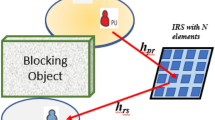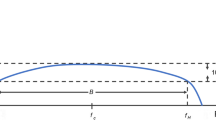Abstract
While characterizing the wireless network, it is critical to predict the exact signal propagation paths in an efficient way for three dimensional (3D) indoor environment. In this paper, a new 3D intelligent ray-tracing (IRT) model based on the modified binary angle division (MBAD) technique is presented. The MBAD algorithm can launch the minimum amount of rays by identifying the invalid regions, which can skip the processing of the unnecessary signals. To further accelerate the MBAD algorithm feasible for the 3D environment, virtual surface technique and efficient polygon test are used. Besides, the amount of time for intersection test is reduced by using the surface skipping technique. Moreover, different radio signal propagation paths, such as reflection, refraction, and diffraction from 3D objects along with infinitesimal rays with very small wavefront are considered. The results obtained from this study show the superiority of the proposed model in terms of higher prediction accuracy (29.21 %) and better computational time (58.78 %) than other well-known techniques. Finally, this work also analytically examines the measured and the simulated results for the proposed IRT model and evaluates the effectiveness. The experimental results are compared with the simulated results obtained from IRT model and good agreement (accuracy of about 97 to \(>\)99 %) demonstrated.

























Similar content being viewed by others
References
Sarker, M. S., Reza, A. W., & Dimyati, K. (2011). A novel ray-tracing technique for indoor radio signal prediction. Journal of Electromagnetic Waves and Applications, 25, 1179–1190.
Zhong, J. (2001). Efficient ray-tracing methods for propagation prediction for indoor wireless communications. IEEE Antennas and Propagation Magazine, 43(2), 41–49.
Cocheril, Y., & Vauzelle, R. (2007). A new ray-tracing based wave propagation model including rough surfaces scattering. Progress in Electromagnetics Research, 75, 357–381.
Kim, H., & Lee, H.-S. (2009). Accelerated three dimensional ray tracing techniques using ray frustums for wireless propagation models. Progress in Electromagnetics Research, 96, 21–36.
Mohtashami, V., & Shishegar, A. A. (2010). Accuracy and computational efficiency improvement of ray tracing using line search theory. IET Journal on Microwaves, Antennas & Propagation, 4, 1290–1299.
Liu, Z.-Y., & Guo, L.-X. (2011). A quasi three-dimensional ray tracing method based on the virtual source tree in urban microcellular environments. Progress in Electromagnetics Research, 118, 397–414.
Ling, H., Chou, R., & Lee, S. (1989). Shooting and bouncing rays: Calculating the RCS of an arbitrarily shaped cavity. IEEE Transactions on Antennas Propagation, 37, 194–205.
Tan, S. Y., & Tan, H. S. (1996). A microcellular communications propagation model based on the uniform theory of diffraction and multiple image theory. IEEE Transactions on Antennas Propagation, 44, 1317–1326.
Chen, S., & Jeng, S. (1997). An SBR/image approach for radio wave propagation in indoor environments with metallic furniture. IEEE Transactions on Antennas Propagation, 45, 98–106.
Zhuang, L., Zhang, Y., Hu, W., Yu, W., & Zhu, G.-Q. (2008). Automatic incorporation of surface wave poles in discrete complex image method. Progress in Electromagnetics Research, 80, 161–178.
Saeidi, C., Hodjatkashani, F., & Fard, A. (2009). New tube-based shooting and bouncing ray tracing method. Proceedings of the International Conference on Advanced Technologies for Communications, Hai Phong, 269–273.
Dikmen, F., Ergin, A. A., Sevgili, A. L., & Terzi, B. (2010). Implementation of an efficient shooting and bouncing rays scheme. Microwave and Optical Technology Letters, 52, 2409–2413.
Gao, P. C., Tao, Y.-B., & Lin, H. (2010). Fast RCS prediction using multiresolution shooting and bouncing ray method on the Gpu. Progress in Electromagnetics Research, 107, 187–202.
Tao, Y. B., Lin, H., & Bao, H. J. (2010). GPU-based shooting and bouncing ray method for fast RCS prediction. IEEE Transactions on Antennas and Propagation, 58, 494–502.
Lining, Z., Lipo, W., & Weisi, L. (2012). Generalized biased discriminant analysis for content-based image retrieval. IEEE Transactions on Systems, Man, and Cybernetics, Part B: Cybernetics, 42(1), 282–290.
Tiberi, G., Bertini, S., Malik, W. Q., Monorchio, A., Edwards, D. J., & Manara, G. (2009). Analysis of realistic ultrawideband indoor communication channels by using an efficient ray-tracing based method. IEEE Antennas and Propagation Magazine, 57(3), 777–785.
Tao, Y. B., Lin, H., & Bao, H. J. (2008). KD-tree based fast ray tracing for RCS prediction. Progress in Electromagnetics Research, 81, 329–341.
Mohtashami, V., & Shishegar, A. A. (2010). Efficient shooting and bouncing ray tracing using decomposition of wavefronts. IET Journal on Microwaves, Antennas & Propagation, 4, 1567–1574.
Mohtashami, V., & Shishegar, A. A. (2012). Modified wavefront decomposition method for fast and accurate ray-tracing simulation. IET Microwaves, Antennas & Propagation, 6(3), 293–304.
Reza, A. W., Dimyati, K., Noordin, K. A., & Sarker, M. S. (2011). Intelligent ray-tracing: An efficient indoor ray propagation model. IEICE Electronics Express, 8, 1–7.
Glassner, A. (1989). An introduction to ray tracing, The Morgan Kaufmann Series in Computer Graphics Academic Press.
De Greve, B. (2006). Reflections and refractions in ray tracing. http://www.flipcode.com/archives/reflection_transmission.pdf.
Choi, J., Sellen, J., & YAP, C.-K. (1995). Precision-sensitive shortest path in 3-space. In Proceeding of 11th ACM symposium on computational geometry, pp. 350–359.
Hormann, K., & Agathos, A. (2001). The point in polygon problem for arbitrary polygons. Computational Geometry, 20(3), 131–144.
Rappaport, T. S. (2002). Wireless communications—Principles and practice (2nd ed.). Upper Saddle River, NJ: Prentice Hall.
Fujii, T., Ohta, Y., & Omote, H. (2009). Empirical time-spatial propagation model in outdoor NLOS environments for wideband mobile communication systems. In IEEE 69th vehicular technology conference, pp. 1–5.
Molisch, A. F., Cassioli, D., Chia-Chin, C., Emami, S., Fort, A., Kannan, B., et al. (2006). A comprehensive standardized model for ultrawideband propagation channels. IEEE Transactions on Antennas and Propagation, 54(11), 3151–3166.
Witrisal, K., Yong-Ho, K., & Prasad, R. (2001). A new method to measure parameters of frequency-selective radio channels using power measurements. IEEE Transactions on Communications, 49(10), 1788–1800.
Omote, H., & Fujii, T. (2007). Empirical arrival angular profile prediction formula for mobile communication systems. In IEEE 65th vehicular technology conference, pp. 599–603.
Acknowledgments
Our sincere thanks go to the University of Malaya for offering extensive financial support under the University of Malaya Research Grant (UMRG) scheme (RG098/12ICT).
Author information
Authors and Affiliations
Corresponding author
Rights and permissions
About this article
Cite this article
Reza, A.W., Noordin, K.A., Islam, M.J. et al. Investigation of a New 3D Intelligent Ray-Tracing Model. Wireless Pers Commun 77, 691–717 (2014). https://doi.org/10.1007/s11277-013-1532-y
Published:
Issue Date:
DOI: https://doi.org/10.1007/s11277-013-1532-y




